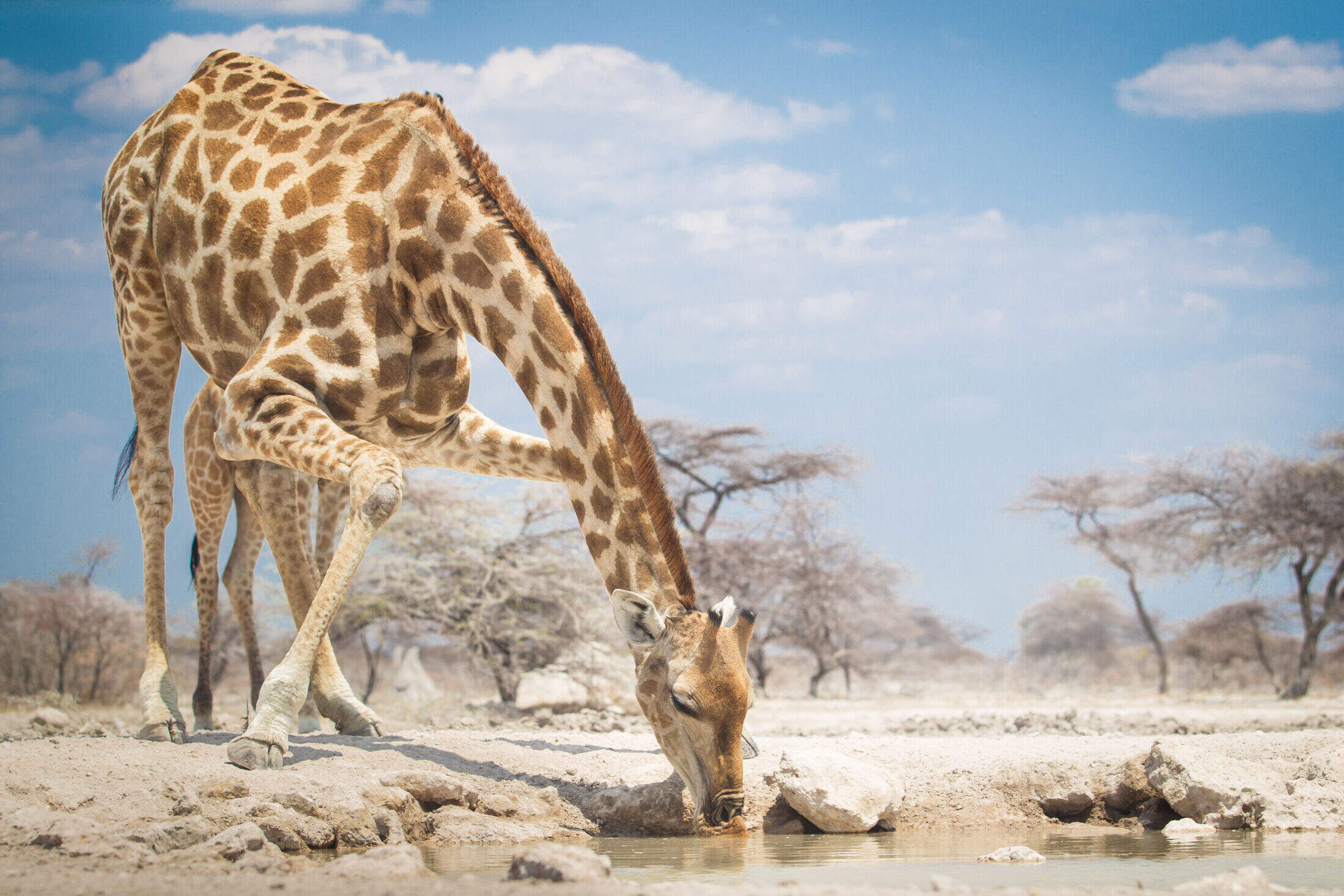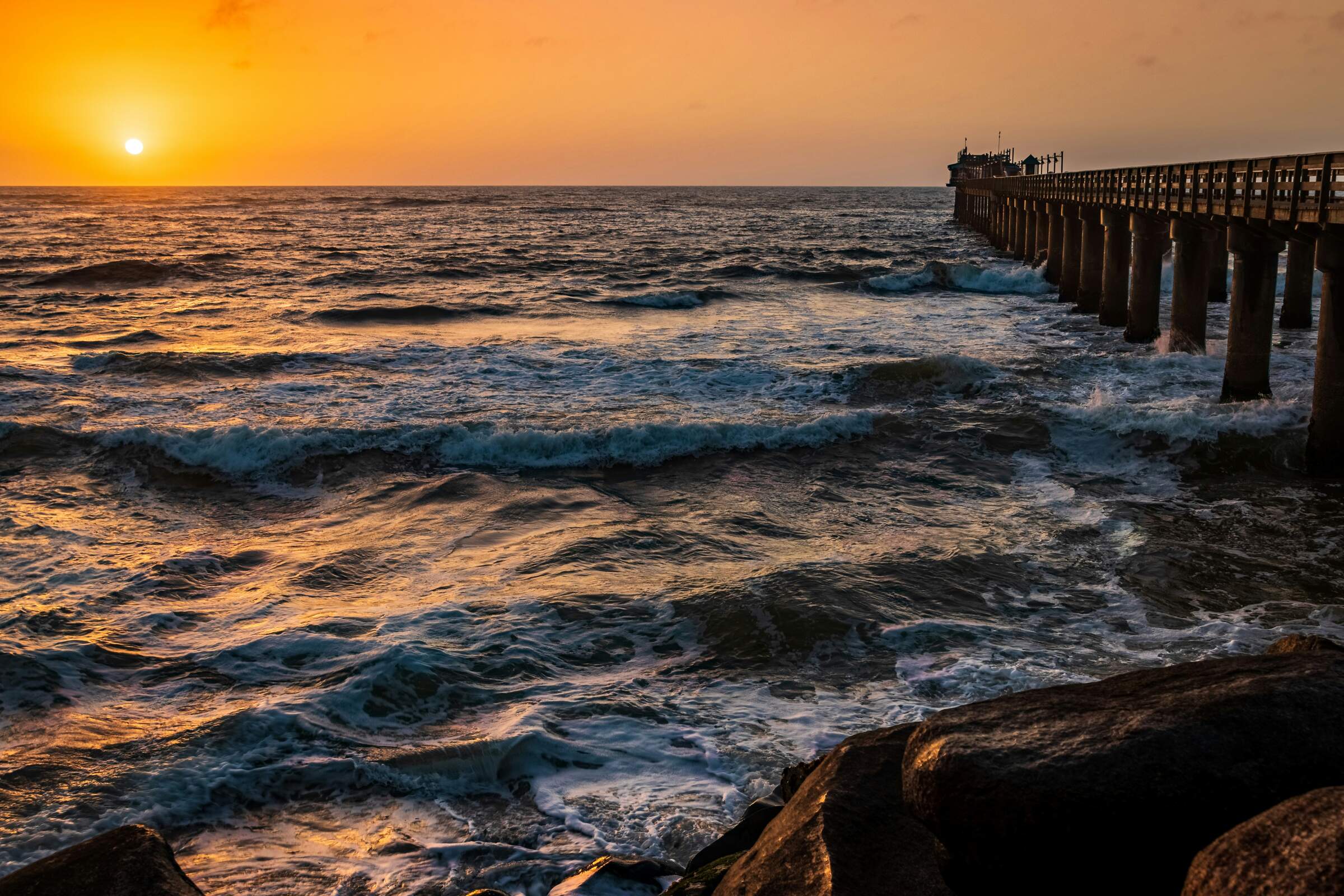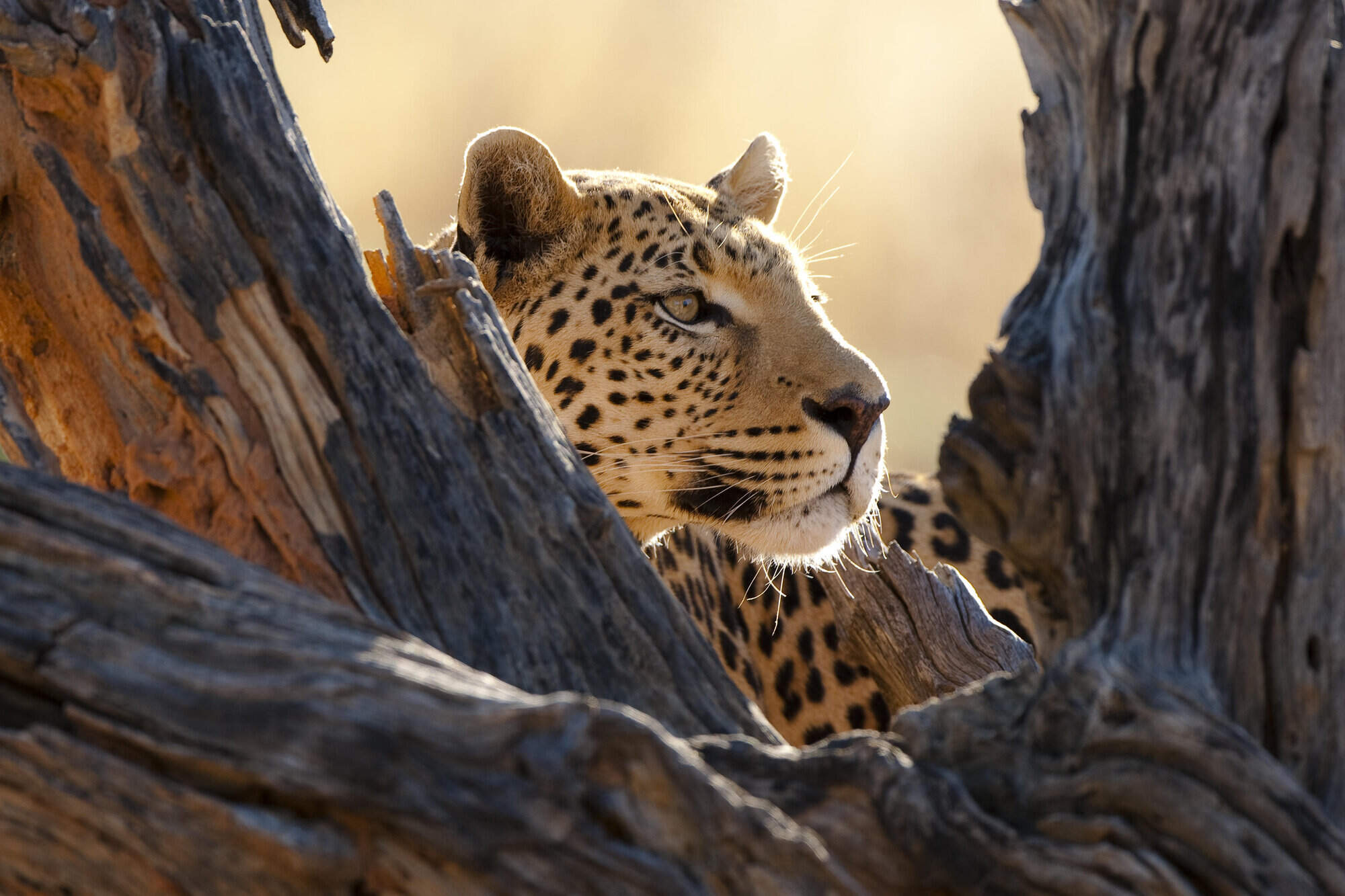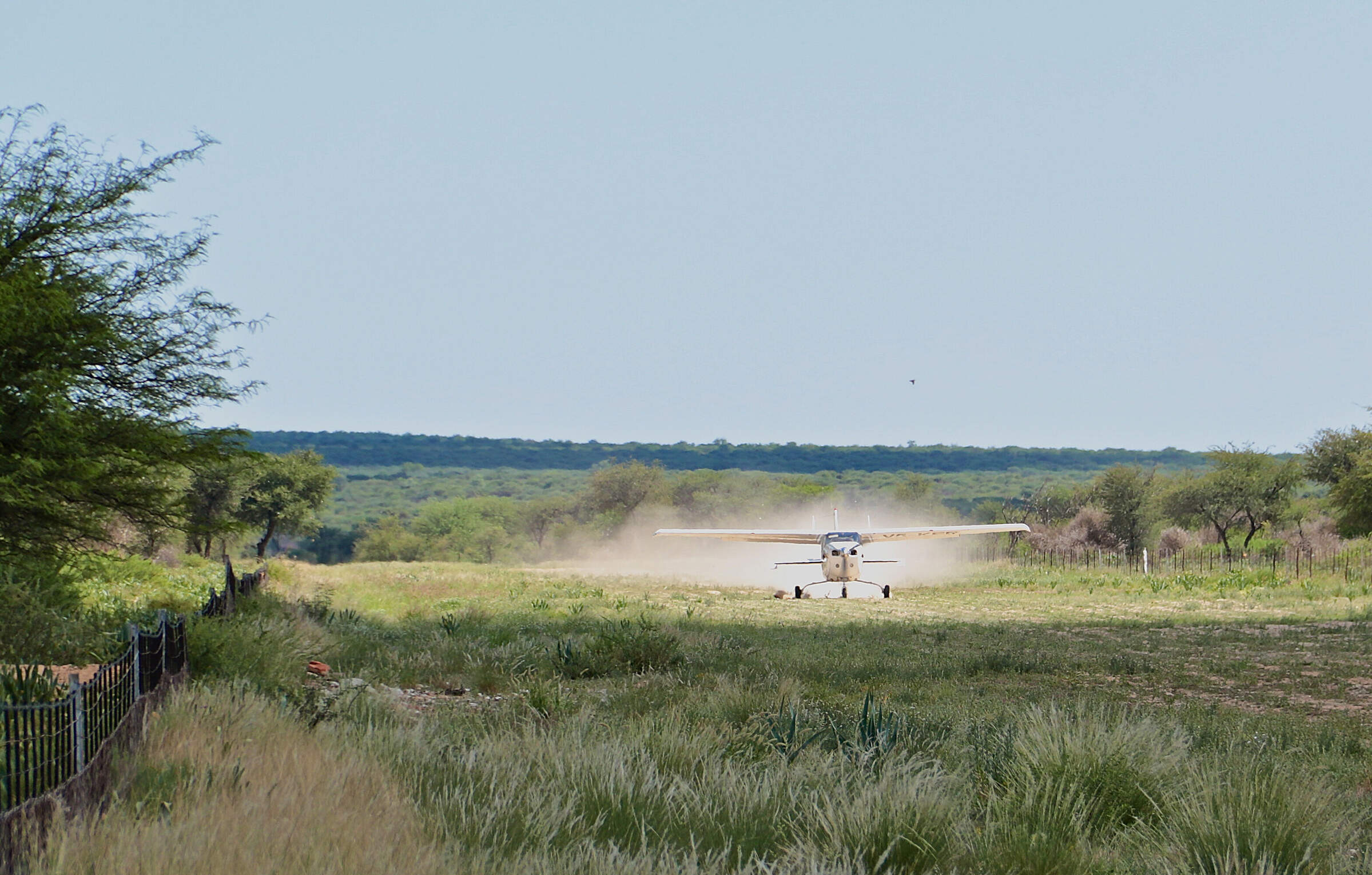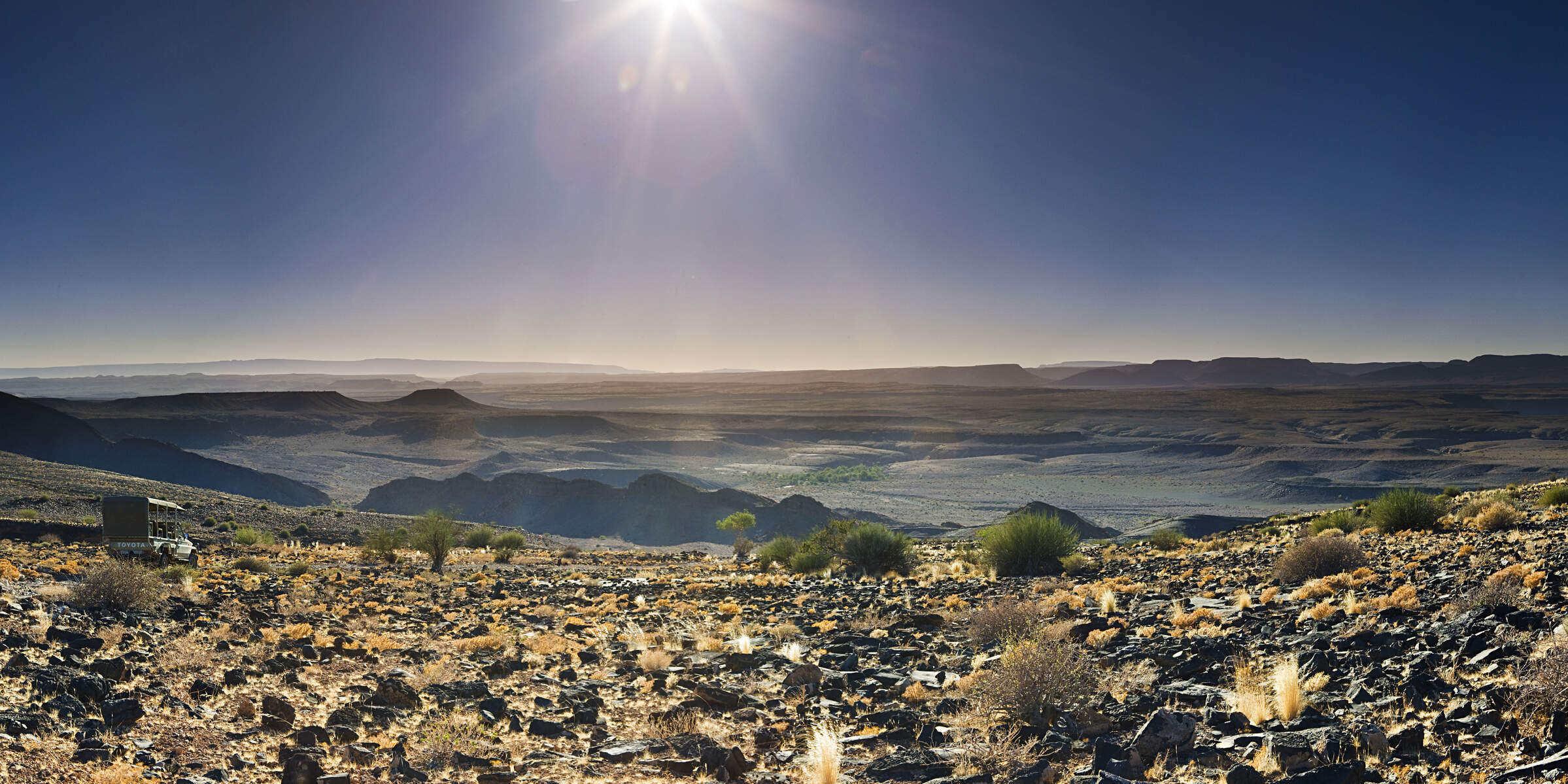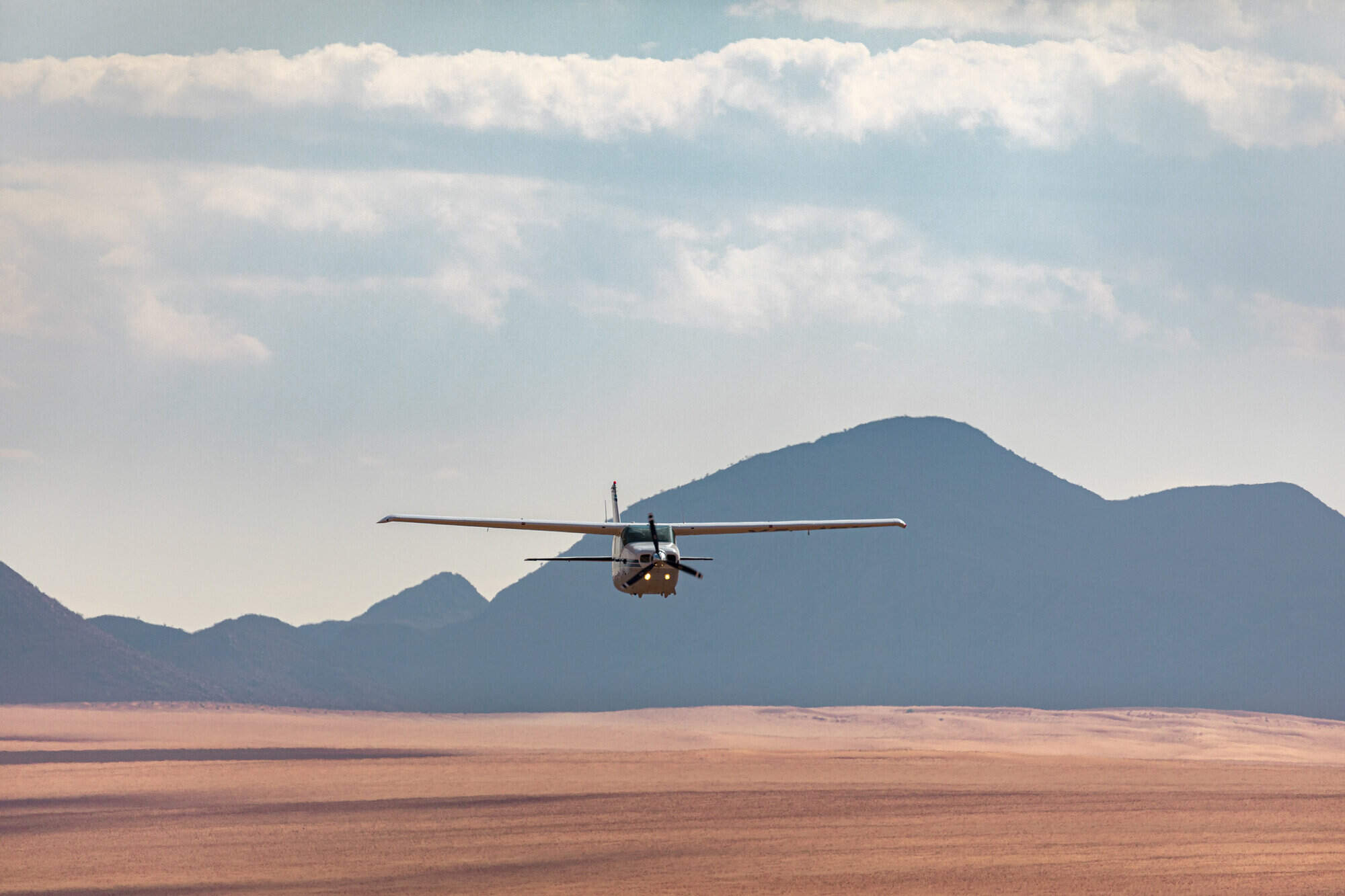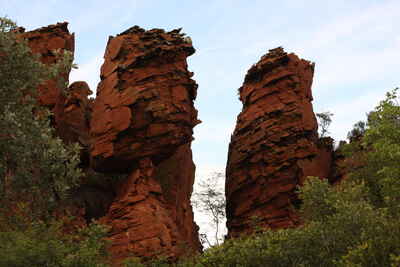
Sandstone sculpted into fascinating shapes.
home to a large variety of animals.
White rhino are a real highlight.
grasslands and wooden areas ideal for hiking trips.
Waterberg Plateau National Park
Waterberg Plateau National Park
Like a giant fortress, the sheer cliffs that surround the Waterberg Plateau stand tall and proud above the foothills.
As if to accentuate their impregnability, this is the only breeding place in Namibia for the Cape vulture, watched over from on high by Verreaux’s (black) eagles. It’s an impressive sight.
Dating back some 200 million years, the sandstone heart of the plateau is imprinted with equally ancient dinosaur footprints. Open grasslands and lush woodlands are dissected by deep ravines, while springs at the base of the escarpment nourish the surrounding plains.
Antelope – from eland to the diminutive Damara dik-dik – thrive in this isolated sanctuary. White rhino have been re-introduced here, along with roan and sable antelope. And while this is classic leopard country, there is competition for the spoils from both cheetah and brown hyena.
Waterberg is unusual among Namibian national parks in that you are not allowed to drive yourself around. While there are guided drives morning and afternoon, including cultural trips to Herero villages, the plateau is foremost a haven for the hiker. Short, waymarked trails offer a gentle introduction to the terrain, but for serious walkers it’s all about the excellent three- or four-day wilderness trails.
Keen birders, too, are in their element, with more than 200 species of bird identified here, while more sobering is the military cemetery, commemorating German casualties from the 1904 Battle of Waterberg against the Herero people.
But most of all, Waterberg offers the opportunity to explore this unique destination at your own pace, to retreat into an area of innate natural beauty, to be at one with your surroundings.

Our top trips in Namibia
Here are 23 great Namibia trips to inspire you.

Chongololo Self-drive Safari
21 days • 11 locations
WINDHOEK AIRPORT TO WINDHOEK AIRPORT
This self-drive safari focuses on the best walking experiences in Namibia. Get your boots ready for the apricot dunes of the Namib Desert and the ancient hills of Damaraland.
US$8,700 - US$9,610 per person

Hartebeest Self-drive Safari
16 days • 8 locations
WINDHOEK AIRPORT TO WINDHOEK AIRPORT
This self-drive safari focuses on the best cultural experiences in Namibia. Visit a Himba village and enjoy three days living with the San Bushmen interspersed with some excellent wildlife watching.
US$4,430 - US$4,690 per person
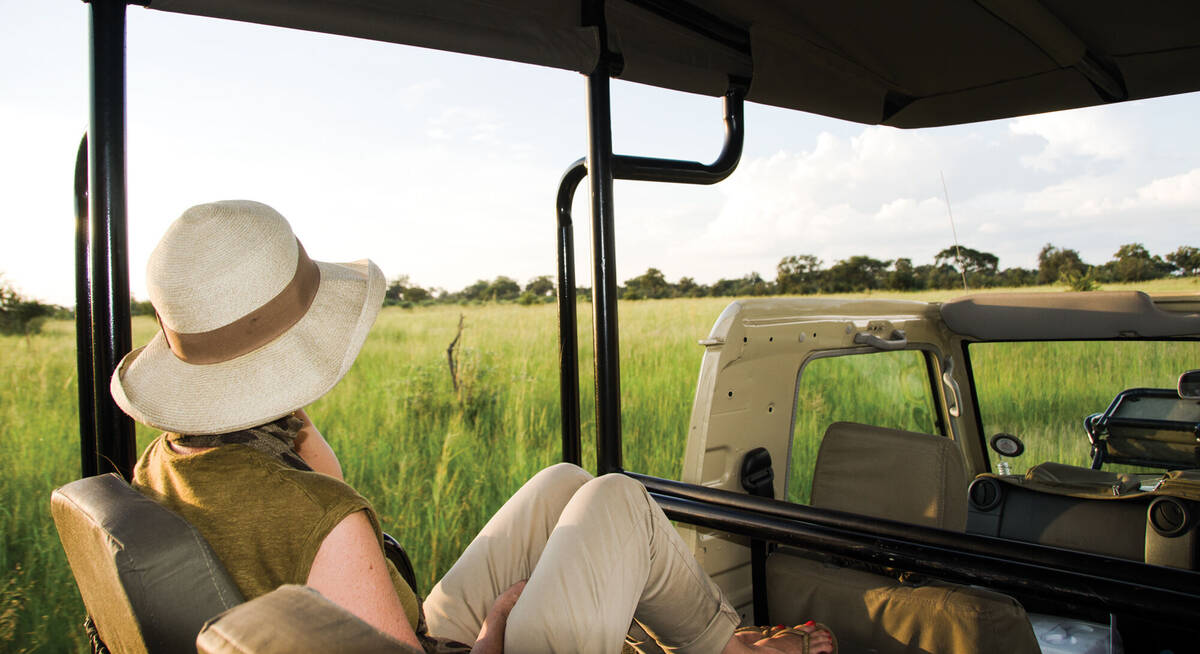
Rock Hare Self-drive Safari
20 days • 12 locations
WINDHOEK AIRPORT TO VICTORIA FALLS AIRPORT
An in-depth look at Namibia from the Namib Desert to the Caprivi, with additional stops in Botswana and Victoria Falls. This three-week adventure includes an unrivalled mix of environments and is great value.
US$7,230 - US$8,170 per person

Caracal Self-drive Safari
14 days • 8 locations
WINDHOEK AIRPORT TO WINDHOEK AIRPORT
The quintessential Namibian self-drive adventure exploring the highlights from Sossusvlei and the Namib Desert to Damaraland’s wilderness and a safari in Etosha. A great mix of accommodation and excellent value.
US$3,190 - US$4,000 per person

Dune Lark Fly & Drive Safari
14 days • 8 locations
WINDHOEK AIRPORT TO WINDHOEK AIRPORT
A combination fly-in self-drive exploration of Namibia, with quick, easy and scenic flights in and out of Sossusvlei before a classic road trip adventure of the country’s rugged north.
US$5,210 - US$5,590 per person
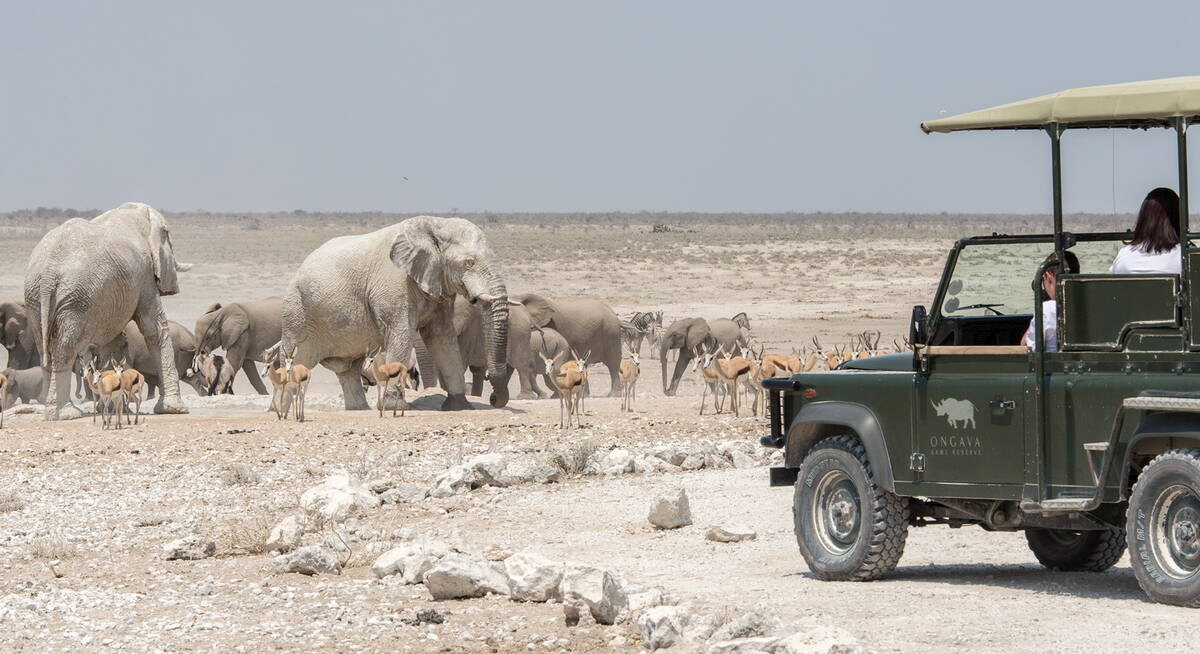
Brown Hyena Self-drive
14 days • 8 locations
WINDHOEK AIRPORT TO WINDHOEK AIRPORT
The perfect trip for those who want to mix the adventure and freedom of a self-drive with some of our favourite luxury camps in Namibia and a great mix of activities.
US$8,700 - US$9,590 per person

Quiver Tree Self-drive Safari
14 days • 7 locations
WINDHOEK AIRPORT TO WINDHOEK AIRPORT
An offbeat Namibian self-drive adventure exploring the epic Fish River Canyon and fascinating Kolmanskop ghost town in the south, before turning north via the classic highlights of Sossusvlei, Swakopmund and Damaraland.
US$3,360 - US$3,560 per person
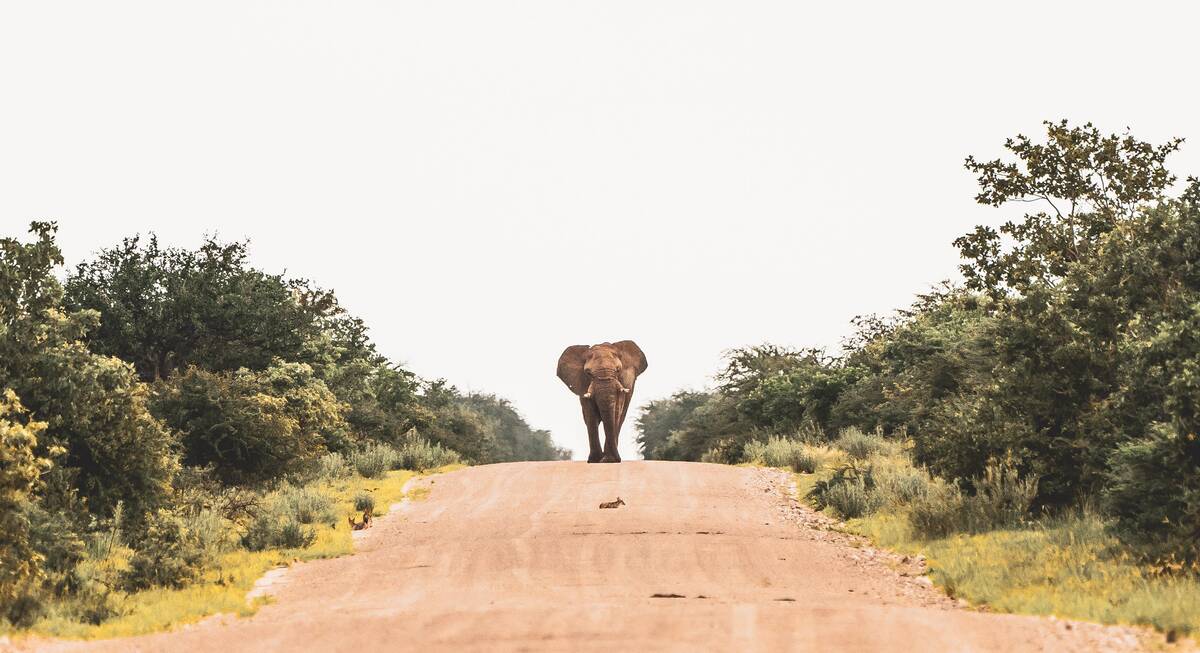
Black Wildebeest Self-drive Safari
19 days • 10 locations
CAPE TOWN AIRPORT TO WINDHOEK AIRPORT
Journey from South Africa’s cosmopolitan Cape Town to central Namibia’s Okonjima Nature Reserve during this self-driven safari. The route passes through a stunning variety of landscapes, offering access to this beautiful continent’s rich diversity.
US$4,020 - US$4,130 per person

Cape Fox Guided Safari
13 days • 7 locations
WINDHOEK AIRPORT TO WINDHOEK AIRPORT
A classic clockwise circuit around Namibia’s northern highlights with a private guide and vehicle. We can’t think of a better way to see more in this timeframe.
US$11,120 - US$12,950 per person

Black-faced Impala Guided Safari
13 days • 6 locations
WINDHOEK AIRPORT TO WINDHOEK AIRPORT
A unique mix of luxury and adventure in our original, and perhaps most varied, destination on a privately guided Namibian overland safari. Perfect for families, friends or couples travelling together.
US$13,010 - US$15,160 per person
Most recent reviews of our safaris to Waterberg Plateau
Click below to browse all 106 reviews from Waterberg Plateau National Park. All from our travellers; all are in full & unedited.
Arrived 21 May 2023, 23 nights
"My May 2023 trip"
Overall rating: Excellent
Arrived 11 Sep 2022, 20 nights
"My Sep 2022 trip"
Overall rating: Excellent
Arrived 23 Jul 2022, 18 nights
"Great holiday in Namibia"
Overall rating: Excellent
Arrived 4 Oct 2019, 30 nights
"Fabulous! Exceeded our expectations!"
Overall rating: Excellent
Arrived 7 Sep 2019, 34 nights
"Great experience"
Overall rating: Excellent
Arrived 19 Apr 2018, 25 nights
"Terrific trip"
Overall rating: Excellent
Arrived 26 Jul 2017, 27 nights
"10 out of 10"
Overall rating: Excellent
Arrived 20 Jul 2017, 19 nights
"My Jul 2017 trip"
Overall rating: Excellent
Arrived 9 Jul 2017, 24 nights
"My Jul 2017 trip"
Overall rating: Excellent
Arrived 10 May 2017, 16 nights
"Kalahari and Caprivi trip"
Overall rating: Excellent
Where to stay in Waterberg Plateau
Our suggestions for safari camps in Waterberg Plateau National Park
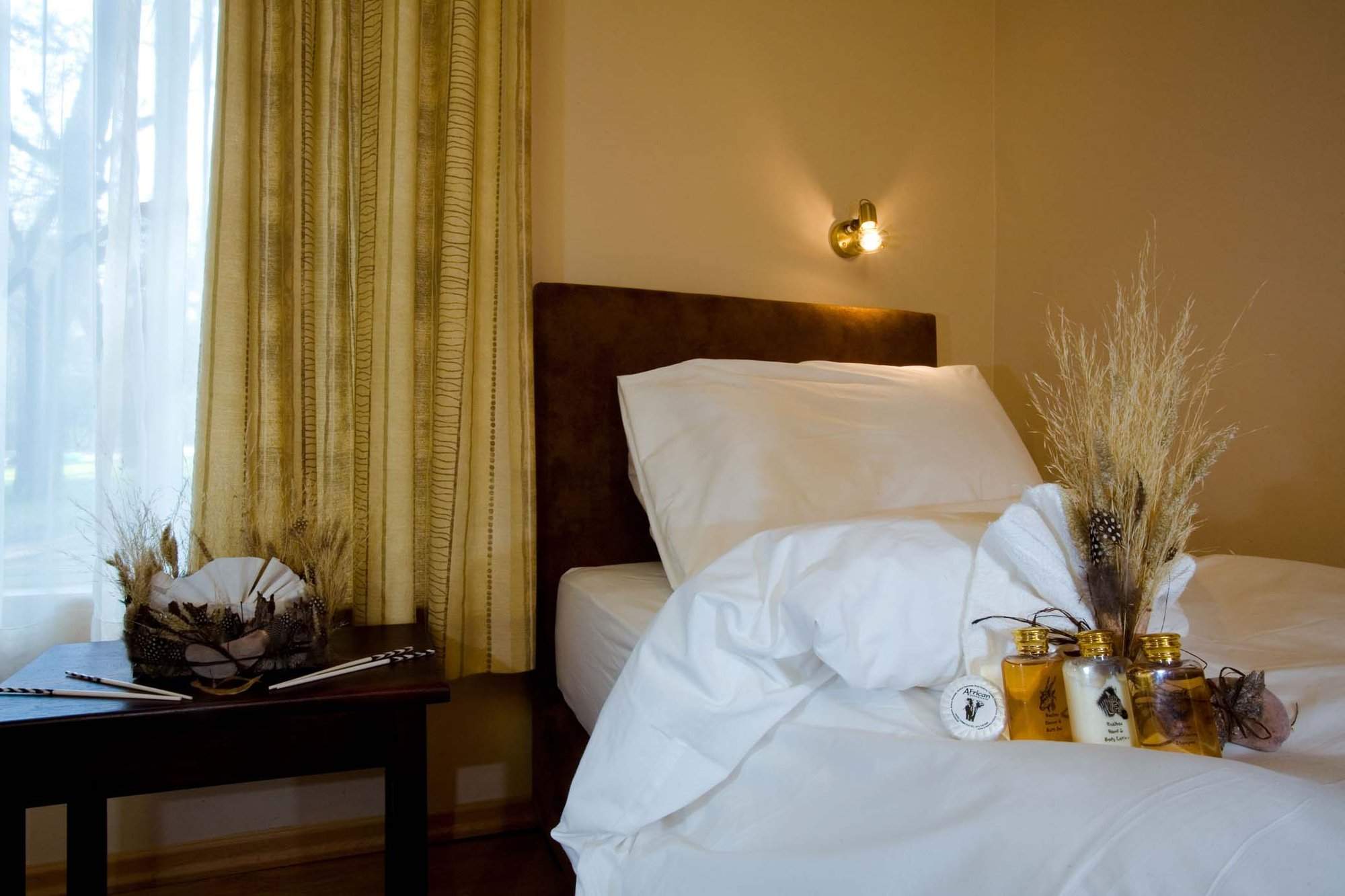
Waterberg Camp
Within the Waterberg Plateau National Park, the newly refurbished government-run Waterberg Camp offers a great location for hiking and birdwatching.

Waterberg Wilderness
Holiday in Namibia's Waterberg Plateau National Park whilst based at the Waterberg Wilderness Lodge.
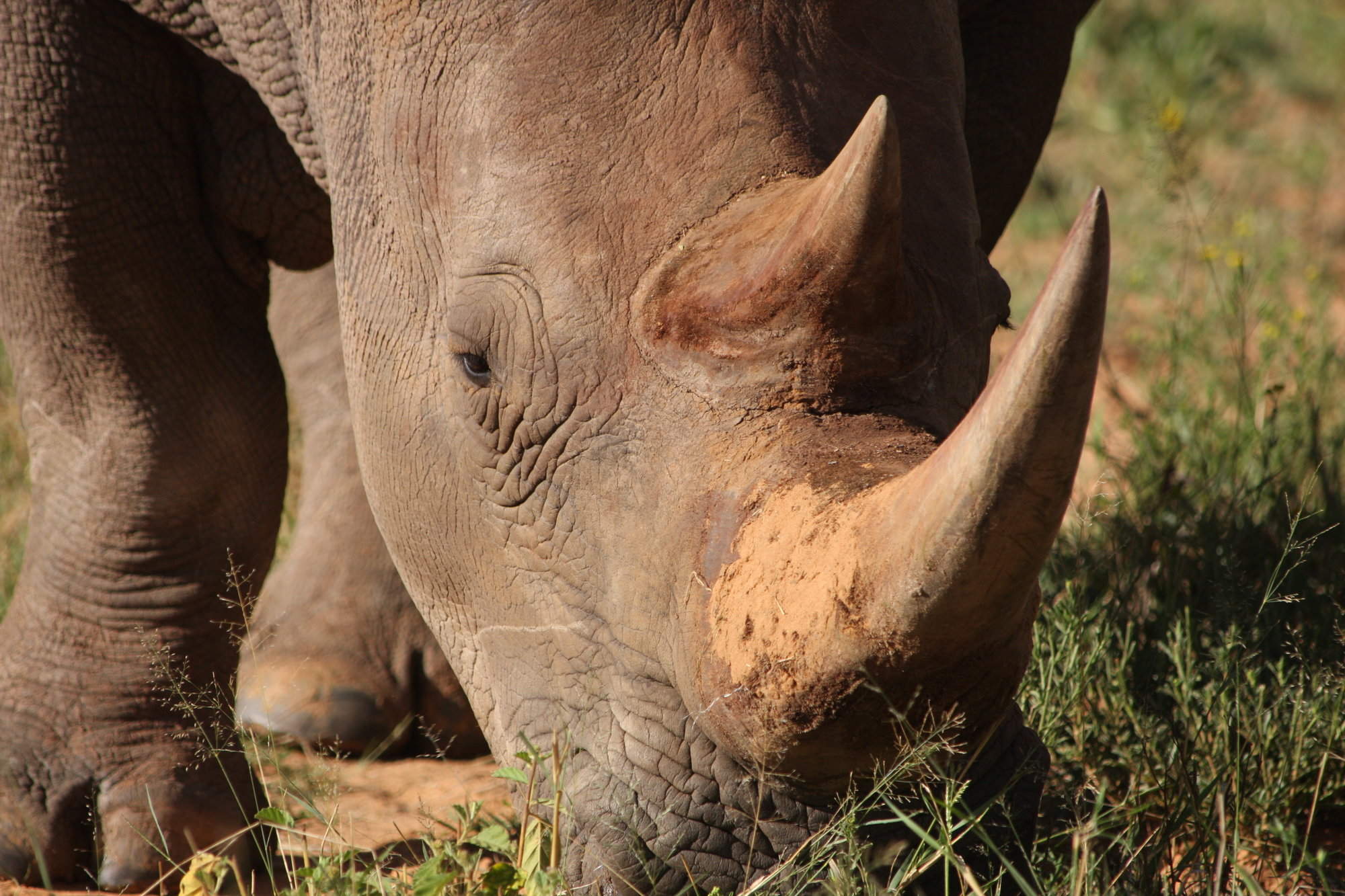
Waterberg Plateau Lodge
Although outside the Waterberg Plateau National Park, Waterberg Plateau Lodge has perhaps the most spectacular views of the lodges in this area.
Our travellers’ wildlife sightings in Waterberg Plateau
This is their success for sightings in Waterberg Plateau National Park. Click on a species for more detail. How we work this out.

60% success

50% success

50% success

40% success

33% success

33% success

25% success

20% success

0% success

0% success

0% success

0% success

0% success
When to go to Waterberg Plateau National Park
Our month by month guide: What it's like to visit Waterberg Plateau in Namibia
Jan
Feb
Mar
Apr
May
Jun
Jul
Aug
Sep
Oct
Nov
Dec
Namibia in January
January is at the heart of Namibia’s rainy season. However, as you’d expect from a country dominated by desert and semi-desert environments, the rains are often (but not always) weak and usually quite localised. Some days will be clear, the strong sun raising temperatures to around 30ºC/86ºF; on others humidity and clouds build, sometimes culminating in spectacular thunderstorms. In extreme cases, these generate flash-floods which race down the beds of ephemeral rivers.
Across the country, the greening landscape makes a refreshing change, especially in desert areas. Many birds are in full breeding plumage and migrant species are here in force. In the north, where the rains are more reliable, the abundant water and food allows wildlife to disperse, making it trickier to spot.
- Variable weather: clear, hot & dry, or cloudy & humid with some rain
- Occasional, highly localised thunderstorms
- Many animals with young; birdlife at its most spectacular
- Wildlife dispersed & harder to see, especially in Etosha & the Caprivi
- Very few tourists (apart from the New Year) so rates mostly low
Our view
This is not a great time to visit
Weather in January
Namibia in February
February is the wettest month, but as Namibia is dominated by deserts, the rains are often weak and patchy. The variation in weather across Namibia is significant, too; the central highlands and Caprivi can see some heavy rain. More typically, some February days are clear with a hot, strong sun; others are cooler as cloudy skies build and, sometimes, culminate in short, spectacular thunderstorms. Occasionally these generate flash-floods, bringing ephemeral rivers to life and making travel more challenging.
Across the country, the landscape feels green and alive; insects and smaller animals are more easily seen, and many birds and animals are raising their young. However, small pools in the bush and thicker vegetation can make it hard to spot the wildlife.
- Variable weather: clear, hot & dry or cloudy & humid with some rain
- Occasional localised thunderstorms meander over the landscape
- The bush feels alive; birdlife is at its most spectacular
- Wildlife in Etosha & Caprivi is dispersed & harder to see
- Few tourists, so rates usually at their lowest
Our view
This is not a great time to visit
Weather in February
Namibia in March
March usually sees Namibia’s main rains tailing off, although actual precipitation varies hugely across the country and can be unpredictable from day to day. Many days will be clear, with a strong sun driving temperatures up. On others, clouds will build, and the late afternoon may see a short, spectacular thunderstorm. Such deluges reduce in both frequency and volume as the month progresses.
Across the country, landscapes are often vivid: a “green and pleasant land”. Many birds and animals are finishing raising their young, so smaller animals and insects are in evidence. In the north, where rains are generally heavier, pools in the bush and thicker vegetation can make it difficult to spot larger animals.
- Variable weather: clear, hot & dry or cloudy & humid with some rain
- Afternoon thunderstorms less common as March progresses
- Animals looking sleek and well-fed, after 3–4 months of plenty
- Wildlife in Etosha & Caprivi is dispersed & harder to see
- Few tourists visit during March, so rates often low
Our view
A good time to visit, with pros & cons
Weather in March
Namibia in April
Typically, April is dominated by dry weather; there’s an ever-decreasing chance of rain. Temperatures are now below their peak and continue to fall. Even so, days remain pleasant and warm, but there might be a slight chill in the air at night. The rains usually leave many parts of the country verdant and green, so animals are in fantastic condition – often with fast-growing young in attendance.
With the dust washed out of the atmosphere, photographers make the most of clear air, spectacular landscapes and healthy animals. Stargazers will have clearer night skies as the month progresses. In the game parks of Northern Namibia, water and food remain in plentiful supply, so finding big game can prove trickier than later in the year.
- Becoming drier &, especially at night, also cooler
- Few visitors, except around Easter, so rates remain low
- Wildlife in Etosha & Caprivi remains relatively hard to see
- Migrant birds have started to leave
- Fresh, clean air and often green, verdant landscapes
Our view
A good time to visit, with pros & cons
Weather in April
Namibia in May
By May, Namibia is usually drying out fast as the rains have ended. If they’ve been good, then the land remains green, but wildlife starts to congregate at more permanent water sources. Over much of the country the air quality and clarity can be amazing, making this an ideal month for photography.
Typical days are warm, with crisp, clear mornings and clear blue skies. Evenings are usually cool, and temperatures may dip below 10ºC (50ºF) overnight. Many lodges still charge “low season” prices, although with Namibia’s increasing popularity in recent years, some have started to introduce higher “shoulder season” rates.
May’s good-value rates, increasingly good wildlife sightings, beautiful landscapes and crystal-clear air combine to make this one of our favourite months in Namibia.
- Lovely weather: dry, warm days & cool nights
- The country is drying out although many landscapes remain green
- Fantastic air clarity – ideal for keen photographers
- Visitor numbers are often still low, mirrored by lodge rates
- Wildlife is starting to congregate more around remaining water
Our view
A very good time to visit
Weather in May
Namibia in June
Namibia is dry again. Skies are blue and usually largely cloudless. Days are lovely: warm and dry; nights are cold, sometimes below freezing in the desert. Most swimming pools in Namibia are always outdoors, making them too cold for all except the very dedicated.
Take a warm hat and gloves for game drives, where dawn and dusk will feel particularly chilly. In the north, especially Etosha, wildlife viewing is now into its dry-season pattern, focusing around the waterholes – though the park is still not busy.
Photographers come for superb air clarity, with minimal dust or smoke in the air. Historically, June rates have been low. However, with Namibia’s increasing popularity many lodges now count it amongst their “high-season” months, and request higher prices.
- Clear, bright days with blue skies; cold nights, mornings & evenings
- Great air quality, especially welcome for photographers
- “Shoulder season” for some lodges: lodge rates moderate
- Wildlife gravitates to waterholes, making game-viewing productive
- Some greenery in the landscape, depending on the last rains
Our view
A very good time to visit
Weather in June
Namibia in July
Reliably warm daytime temperatures (upwards of 20ºC/70ºF) and good wildlife sightings make this a popular month to visit Namibia. Rain would be very unusual indeed and clear skies make for great photographs. Once the sun sets, though, temperatures cool rapidly bringing cold nights that may dip below freezing in the desert. Be prepared: dress in layers and expect early-morning and late-afternoon drives, and anywhere coastal, to be cold.
As the land dries and vegetation shrivels, game congregates beside drinking water: Etosha’s waterholes are busy with animals. Across the country, lodges charge “high season” rates; many are fully booked a year or more in advance, especially during European school holidays (from the latter half of July to late August).
- Dry days, warm in the sun, with crisp, cold nights
- Cloudless skies: July is usually superb for stargazing
- The beginning of European school holidays so more families travelling
- Peak season: so high rates and many lodges fully booked far in advance
- A fantastic time of year for wildlife watching, particularly in Etosha
Our view
A very good time to visit
Weather in July
Namibia in August
August is the height of Namibia’s “winter”. Expect cloudless skies and plenty of warm sun in the day, but nights down to freezing in the desert. Dress in layers and bring warm clothes (including hats and gloves) for chilly starts and evenings. Only the hardiest even contemplate using outdoor pools.
It’s 3–4 months since any rain, so the land is dust-dry and much vegetation is golden brown. Many landscapes appear sparse and harsh. Wildlife congregates around available water sources, helping to guarantee good animal sightings.
Namibia is never really “busy” by the standards of Europe or the USA, but August is the most popular time to visit, especially for families. Book early (over a year in advance) if you want to stay at the best lodges.
- Dry days, warm in the sun; cold mornings, evenings & nights
- Cloudless skies in the day; spectacular stars at night
- Busy by Namibian standards: family rooms in particular demand
- Peak season: so high rates and many lodges fully booked far in advance
- A fantastic time of year for wildlife watching, particularly in Etosha
Our view
Fantastic: the very best time to visit
Weather in August
Namibia in September
September is a month of blue, cloudless skies and fantastic wildlife viewing. Rain is almost unheard of. As the month progresses, the days and nights get warmer. In some areas, daily maximums hit around the low 30s Celsius, although low humidity ensures this feels comfortable. The contrast makes the nights seem very cold. The air is becoming dustier, occasionally augmented by smoke from fires – so becoming hazy for photographic purists.
In the national parks, animals congregate around remaining water sources – making September one of the best months for game viewing. Hence it’s one of Namibia’s most popular months for visitors: a “high season” month that is often the time of choice for safari aficionados.
- One of the best months for wildlife viewing
- Warm days & cold nights, with temperatures rising during the month
- Many plants have faded from green to golden brown
- Air can be hazy – with dust & sometimes smoke
- High season rates; many lodges & camps are full 9 months in advance.
Our view
Fantastic: the very best time to visit
Weather in September
Namibia in October
Namibia is usually at its hottest and driest in October. Temperatures build as the month progresses; towards the end, daily highs may exceed 40ºC/100ºF, though with humidity close to zero, even this rarely feels oppressive.
In exceptional years, isolated rain showers may fall in late October. More usually, the end of the dry season sees wildlife watching at its best, particularly in Etosha. The place feels like a desert as spectacular herds of thirsty animals gather around the available water. October is popular amongst wildlife enthusiasts and commands peak-season prices, even if dust and smoke may make the air hazy, challenging photographers. Visitor numbers can fade towards the end of the month, allowing a window for last-minute bookings.
- Probably the most spectacular month for wildlife-viewing in Etosha
- Hot and dry: much of the country feels like a desert
- The air can be hazy with dust & smoke
- It’s peak time to visit, so expect high season rates
- Lodges & camps are full, especially early in October
Our view
A very good time to visit
Weather in October
Namibia in November
November is always a bit unpredictable: sometimes dry and hot; sometimes cloudier and cooler. Typically, mornings are hot and cloudless and clouds appear in the afternoon. Humidity builds and eventually breaks, resulting in spectacular thunderstorms that bring convection rainfall in late afternoons. Such storms are typically sparsely distributed and highly local – being completely absent from desert areas, for example. Places that do get good rain will flush green, with a tangible feeling of new life softening the landscapes. Many mammals give birth to their young.
Once any rains come, wildlife dissipates in search of food, and game viewing in Etosha becomes harder. Conversely, this is a great time for birdwatchers, with migrant species in breeding plumage.
- A very interesting, variable month, depending on the rains
- With rains come an amazing explosion of both vegetation & new life
- Wildlife viewing better in Damaraland than Etosha if it has rained
- Shoulder season: mid-range rates offer great value
- Away from the Namib, showers are more likely later in the month
Our view
A good time to visit, with pros & cons
Weather in November
Namibia in December
December is the first “proper” month of Namibia’s rainy season, and one of its hottest. Clear mornings give way to building clouds and, with luck, the occasional short, spectacular thunderstorm: refreshing and cleansing. These are often highly localised and generally warmly welcomed: most Namibians love rain!
Rains clear the air of dust. Even relatively short showers enable plant life to erupt, carpeting this thirstland in green and providing food for the young animals which abound. Animals disperse widely, which can make game viewing challenging. Many birds are breeding and so sporting their most colourful plumage.
Christmas and the New Year fall within local “summer holidays” – so places to stay can be surprisingly busy, especially in and around coastal towns, where temperatures are cooler.
- Hot and humid; sometimes refreshed by cooling showers
- Landscapes flushed green if/where there has been rain
- A tangible life and energy amidst this often green & pleasant land
- Very photogenic: blooming deserts amidst crystal-clear air
- Best time for birdwatchers; larger animals harder to spot
Our view
This is not a great time to visit
Weather in December
Waterberg Plateau National Park: In detail
Waterberg Plateau National Park
East of the Central Highlands, Waterberg Plateau is a unique flat-topped plateau with stunning scenery and excellent wildlife.
It’s largely made up of sandstone, often sculpted into amazing shapes, and is dotted with freshwater springs. The diverse patchwork of wooded areas, grasslands and verdant ravines on the top is particularly well suited to hiking trips.
Given the plateau’s isolated nature, endangered species, including white rhino, roan and sable antelope, have been reintroduced to Waterberg over the years, to add to its rich existing game. The birdlife is equally impressive, with more than 200 species, including spectacular Verreaux’s (black) eagles and Namibia’s only breeding colony of Cape vultures.
History of the Waterberg Plateau Area
The site of the battle is today within the Waterberg Plateau Park, where the German soldiers who perished are buried in a military graveyard.
Geography of the Waterberg Plateau
Flora and Fauna of the Waterberg Plateau
Waterberg has become an integral part of a number of conservation projects, seeing the relocation of several endangered species (including white rhino, roan and sable antelope) in an attempt to start viable breeding herds. These have added to the game already found here, which ranges from giraffe and kudu to leopard, brown hyena, cheetah and (reports claim) wild dog.
The birdlife is no less impressive, with more than 200 species on record. Most memorable are the spectacular Verreaux’s (black) eagles, and Namibia’s only breeding colony of Cape vultures. Although REST (the Rare and Endangered Species Trust) is working to conserve these imposing raptors, numbers have sharply declined in recent years due to both the changing environment and the increasing use of farm poisons (both intentional poisons, and the chemicals in fertilisers and pesticides). One innovation encourages the birds to eat at a vulture restaurant (open once a week, on Wednesday morning) where carcasses are prepared and left out for them.
What to see and do in the Waterberg Plateau National Park
Keen walkers will book in advance one of the excellent wilderness trails. But if you haven’t done this, then there are some good marked trails around the camp area, and even up onto a lookout point on the plateau.
Organised drives lasting about three hours take place in the morning and late afternoon, and are best booked with the park office as soon as you arrive. They tour around the plateau in search of game, visiting the permanent waterholes and some of the hides. However, although the guiding is usually good, and there are chances of seeing uncommon sable and roan antelope, the bush here is thicker and the game densities appear much lower than, say, Etosha, so, many visitors find the game disappointing. One possibility for the dedicated is to take the morning trip on to the plateau, get off at one of the hides, and spend the day there game-watching. You need to take some food and water (and perhaps a good book), but can then return to camp with the afternoon drive.
There are also organised nature or cultural tours available where the guide will ride in your vehicle. These typically will take three to four hours, and include visits to a traditional Herero village, and perhaps a community centre or school, with the opportunity to try local food.
Between the reception and restaurant, a side road leads to a war cemetery where intricate headstones commemorate German soldiers killed in the Waterberg Battle during the 1904 Herero uprising led by Chief Samuel Maharero. Perhaps unsurprisingly, there are no equivalent memorials to the Herero.
Hiking
If you come to Waterberg for the walking, then you won’t be disappointed. There are nine short trails around the vicinity of the camp, designed to give visitors a flavour of the park. These are open all year and are described in booklets from the park's office. The panorama from the end of the trail up to Mountain View is definitely worth the effort and time (about 45 minutes) that it takes to get there.
During the dry season, from April to November, there are also two longer hikes organised: an accompanied one in the west of the park, and an unguided alternative in the south. There is no better way to experience this game park, though reservations must be made months in advance.
For both hikes you need to bring your own sleeping bag, food and cooking utensils. You will sleep in stone shelters, and be provided with simple long-drop toilets and water.
- Waterberg Wilderness Trail
The three-day accompanied 42km hiking trail runs from (currently) 2.00pm on Thursday to Sunday afternoon, on the second, third and fourth weekends from April to November. Each hike takes just one group of between six and eight people.
The trail starts at Onjoka Gate, the wildlife administration centre, from where the group is driven up onto the plateau. There is no set trail to follow; the warden leading the trail will just guide you across the plateau and go wherever looks interesting. The distance covered will depend on the fitness and particular interests of the group, but 10–15km per day would be typical. This is not an endurance test, but an excellent way to get to know more about the environment with the help of an expert guide. - Unguided trail
The four-day unguided 50km trail runs during the same period, but usually starts every Wednesday at 9.00am, and returns on Saturday. Only one group of three to ten people is allowed on the trail each week.
Walkers start at the resort office, following the road up to the Mountain View trail and then onto the top of the escarpment, where the trail itself begins. From here it is a relatively short 42km. The first night is spent at the Otjozongombe shelter, and the second and third nights at the Otjomapenda shelter, allowing you to make a circular day-walk of about 8km. This all takes place around the spectacular sandstone kopjes on the southern edge of the plateau.
Map of Waterberg Plateau National Park
Choices for where to stay in Waterberg Plateau National Park
Our top 3 lodges and safari camps in Waterberg Plateau National Park
Listed below are our best lodges in this area. Ask us for more details of what's where, and what's likely to suit you best!

Waterberg Camp
Within the Waterberg Plateau National Park, the newly refurbished government-run Waterberg Camp offers a great location for hiking and birdwatching.

Waterberg Wilderness
Holiday in Namibia's Waterberg Plateau National Park whilst based at the Waterberg Wilderness Lodge.

Waterberg Plateau Lodge
Although outside the Waterberg Plateau National Park, Waterberg Plateau Lodge has perhaps the most spectacular views of the lodges in this area.

Looking for inspiration on where to travel next?
Visit our trip chooser to explore your options and find inspiration for your perfect African adventure
Inspire me